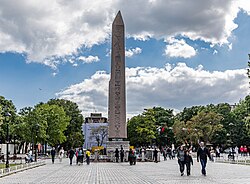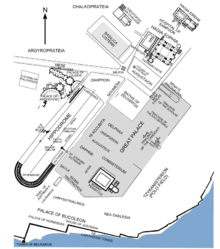Hippodrome of Constantinople
Parts of this article (those related to the modern square) need to beupdated.(March 2021) |
This articleneeds additional citations forverification.(August 2023) |
| Hippodrome | |
|---|---|
| Sultanahmet Square (Sultanahmet Meydanı) | |
 Obelisk of Theodosiusin Sultanahmet Square today | |
 | |
| Location | Istanbul,Turkey |
| Coordinates | 41°00′23″N28°58′33″E/ 41.00639°N 28.97583°E |
TheHippodrome of Constantinople(Greek:Ἱππόδρομος τῆς Κωνσταντινουπόλεως,romanized:Hippódromos tēs Kōnstantinoupóleōs;Latin:Circus MaximusConstantinopolitanus;Turkish:Hipodrom), was acircusthat was the sporting and social centre ofConstantinople,capital of theByzantine Empire.Today it is a square inIstanbul,Turkey,known asSultanahmet Square(Turkish:Sultanahmet Meydanı).
The wordhippodromecomes from the Greekhippos(ἵππος),horse,anddromos(δρόμος), path or way. For this reason, it is sometimes also calledAtmeydanı( "Horse Square" ) in Turkish.Horse racingandchariot racingwere popular pastimes in the ancient world and hippodromes were common features of Greek cities in theHellenistic,Roman,and Byzantine eras.
History and use
[edit]Construction
[edit]
Although the Hippodrome is usually associated with Constantinople's days of glory as an imperial capital, it actually predates that era. The first Hippodrome was built when the city was calledByzantium,and was a provincial town of moderate importance. In AD 203 the EmperorSeptimius Severusrebuilt the city and expanded itswalls,endowing it with a hippodrome, an arena for chariot races and other entertainment.
In AD 324, the EmperorConstantine the Greatdecided to refound Byzantium after his victory at the nearbyBattle of Chrysopolis;he renamed itNova Roma(New Rome). This name failed to impress and the city soon became known as Constantinople, the City of Constantine. Constantine greatly enlarged the city, and one of his major undertakings was the renovation of the Hippodrome. It is estimated that the Hippodrome of Constantine was about 450 m (1,476 ft) long and 130 m (427 ft) wide. Thecarceres(starting gates) stood at the northern end; and thesphendone(curved tribune of the U-shaped structure, the lower part of which still survives) stood at the southern end.[1]Thespina(the middle barrier of the racecourse) was adorned with various monuments, including the monolithic obelisk, the erection of which is depicted in relief carvings on its base.
Thestandswere capable of holding 100,000 spectators. The race-track at the Hippodrome was U-shaped, and theKathisma(emperor's lodge) was located at the eastern end of the track. The Kathisma could be accessed directly from theGreat Palacethrough a passage which only the emperor or other members of the imperial family could use.
Decoration
[edit]
The hippodrome was filled with statues of gods, emperors, animals, and heroes, among them some famous works, such as a 4th-century BCHeraclesbyLysippos,RomulusandRemuswith the she-wolfLupa,and the 5th-century BCSerpent Column.[4]Thecarcereshad four statues of horses in gilded copper on top, now called theHorses of Saint Mark.The horses' exactGreekorRomanancestry has never been determined. They were looted during theFourth Crusadein 1204 and installed on the façade ofSt Mark's BasilicainVenice.The track was lined with other bronze statues of famous horses and chariot drivers, none of which survive. In his bookDe Ceremoniis(book II,15, 589), the EmperorConstantine Porphyrogenitusdescribed the decorations in the hippodrome at the occasion of the visit ofSaracenor Arab visitors, mentioning the purple hangings and rare tapestries.[5]According toHesychius of Miletus,there was once a statue ofHecateat the site.[6]
Functions
[edit]Throughout the Byzantine period, the Hippodrome was the centre of the city's social life. Huge amounts were bet on chariot races, and initially four teams took part in these races, each one financially sponsored and supported by a different political party (Deme) within theByzantine Senate:The Blues (Venetoi), the Greens (Prasinoi), the Reds (Rousioi) and the Whites (Leukoi). The Reds (Rousioi) and the Whites (Leukoi) gradually weakened and were absorbed by the other two major factions (the Blues and Greens).
A total of up to eight chariots (two chariots per team), powered by four horses each, competed on the racing track of the Hippodrome. These races were not simple sporting events, but also provided some of the rare occasions in which the emperor and the common citizens could come together in a single venue. Political discussions were often made at the Hippodrome, which could be directly accessed by the emperor through a passage that connected the Kathisma with theGreat Palace of Constantinople.
The rivalry between the Blues and Greens often became mingled with political or religious rivalries, and sometimes riots, which amounted to civil wars that broke out in the city between them. The most severe of these was theNika riotsof 532, in which an estimated 30,000 people were killed[7]and many important buildings were destroyed, such as the nearbysecond Hagia Sophia,the Byzantinecathedral.The current (third) Hagia Sophia was built byJustinian Ifollowing the Nika riots.
Decline
[edit]Constantinople never recovered from its sack during theFourth Crusadeand even though the Byzantine Empire survived until 1453, by that time, the Hippodrome had fallen into ruin, pillaged by the Venetians who likely took thefour horsesnow in San Marco from a monument there.[8]The Ottomans, whose SultanMehmed IIcaptured the city in 1453 and made it the capital of theOttoman Empire,were not interested in chariot racing and the Hippodrome was gradually forgotten, although the site was never actually built over. The hippodrome was used as a source of building stone, however.[9]
Hippodrome monuments
[edit]Serpent Column
[edit]
To raise the image of his new capital, Constantine and his successors, especiallyTheodosius the Great,brought works of art from all over the empire to adorn it. The monuments were set up in the middle of the Hippodrome, thespina.Among these was thesacrificial tripodofPlataea,now known as the Serpent Column, cast to celebrate thevictory of the Greeks over the Persiansduring thePersian Warsin the 5th century BC. Constantine ordered the Tripod to be moved from theTemple of ApolloatDelphi,and set in middle of the Hippodrome. The top was adorned with a golden bowl supported by three serpent heads, although it appears that this was never brought to Constantinople. The serpent heads and top third of the column were destroyed in 1700.[10]Parts of the heads were recovered and are displayed at theIstanbul Archaeology Museum.All that remains of the Delphi Tripod today is the base, known as the "Serpent Column".
Obelisk of Thutmose III
[edit]
Another emperor to adorn the Hippodrome wasTheodosius the Great,who in 390 brought anobeliskfromEgyptand erected it inside the racing track. Carved from pink granite, it was originally erected at theTemple of KarnakinLuxorduring the reign ofThutmose IIIin about 1490 BC. Theodosius had the obelisk cut into three pieces and brought it to Constantinople. The top section survives, and it stands today where Theodosius placed it, on a marble pedestal. Thegraniteobelisk has survived nearly 3,500 years in good condition.
Walled Obelisk
[edit]
In the 10th century the EmperorConstantine Porphyrogenitusbuilt another obelisk at the other end of the Hippodrome. It was originally covered with gilded bronze plaques, but they were sacked by Latin troops in the Fourth Crusade.[1]The stone core of this monument also survives, known as theWalled Obelisk.
Statues of Porphyrius
[edit]Seven statues were erected on theSpinaof the Hippodrome in honour ofPorphyrius the Charioteer,a legendary charioteer of the early 6th century who in his time raced for the two parties which were called "Greens" and "Blues". None of these statues have survived. The bases of two of them have survived and are displayed in the Istanbul Archaeological Museum.
Contemporary description
[edit]
The area is officially called Sultanahmet Square. It is maintained by the Turkish government. The course of the old racetrack has been indicated with paving, although the actual track is some 2 m (6.6 ft) below the present surface. The surviving monuments of theSpina,the two obelisks and the Serpentine Column, now sit excavated in pits in a landscaped garden.
TheGerman Fountain( "The Kaiser Wilhelm Fountain" ), an octagonal domed fountain inneo-Byzantine style,which was constructed by the German government in 1900 to mark the visit of the German EmperorWilhelm IIto Istanbul in 1898, is located at the northern entrance to the Hippodrome area, right in front of the Blue Mosque.
In 1855,Charles Thomas Newton,the English archaeologist who excavatedHalicarnassusandCnidus,excavated the one surviving jaw of a snake from the Serpent Column. The Hippodrome was excavated by the Director of the Istanbul Archeological Museums, archaeologist Rüstem Duyuran in 1950 and 1951.[11][12]A portion of the substructures of thesphendone(the curved end) became more visible in the 1980s with the clearing of houses in the area. In 1993 an area in front of the nearby Sultanahmet Mosque (theBlue Mosque) was bulldozed in order to install a public building, uncovering several rows of seats and some columns from the Hippodrome. Investigation did not continue further, but the seats and columns were removed and can now be seen in Istanbul's museums. It is possible that much more of the Hippodrome's remains still lie beneath the parkland of Sultanahmet.
The Hippodrome was depicted on thereverseof the Turkish 500lirabanknotes of 1953–1976.[13]
Image gallery
[edit]-
Sultanahmet Square from the sky, the surviving lower walls of the Sphendone of the Hippodrome is visible.
-
The four bronze horses that stood atop the Hippodrome boxes, today atSt. Mark's BasilicainVenice
-
Base of the statues of Porphyrios, kept in the Istanbul Museum
-
The Hippodrome in 2005, with theWalled Obeliskin the foreground and theObelisk of Thutmose IIIon the right
-
The base of theObelisk of Thutmose IIIshowing EmperorTheodosiusas he offers alaurel wreathto the victor from theKathismaat the Hippodrome
-
Procession of the guilds in front of the Sultan in the Hippodrome,Ottoman miniaturefrom theSurname-i Vehbi(1582)
-
The Grand Vizier Crossing the AtmeydanıbyJean Baptiste Vanmourshows the Hippodrome and theBlue Mosquein the early 17th century
-
Watercolour of the Hippodrome'sspinaand Hagia Sophia from amanuscriptin the library ofTrinity College, Cambridge
-
Engraving byWilliam WattsafterLuigi Mayerof theAtmeydanıand the Blue Mosque
-
Depiction of an Arab captive demonstrating his skills to the emperor in the Hippodrome. Miniature from the 12th centuryMadrid Skylitzes.
References
[edit]- ^ab"Hippodrome - Istanbul, Turkey Attractions".www.lonelyplanet.com.
- ^E. Jeffreys et al. (eds.),The Oxford handbook of Byzantine studies(2008), 207; R. Krautheimer,Three Christian capitals: topography and politics(1983), 136 n. 14.
- ^Dash, Mike."Blue versus Green: Rocking the Byzantine Empire".
- ^Sarah Guberti Bassett (1991). "The Antiquities in the Hippodrome of Constantinople".Dumbarton Oaks Papers.45.Dumbarton Oaks Papers, Vol. 45: 87–96.doi:10.2307/1291694.JSTOR1291694.
- ^Rodolphe Guilland (1948). "The Hippodrome at Byzantium".Speculum.23(4). Speculum, Vol. 23, No. 4: 676–682.doi:10.2307/2850448.JSTOR2850448.S2CID162820978.
- ^Patria of Constantinople
- ^This is the number given by Procopius,Wars(Internet Medieval Sourcebook.)
- ^"Museo San Marco Venezia - St Mark's Museum Venice Italy".www.venetoinside.com.
- ^"Hippodrome - architecture".Encyclopedia Britannica.
- ^Thomas F. Madden, "The Serpent Column of Delphi in Constantinople: Placement, Purposes, and Mutilations,"Byzantine and Modern Greek Studies16 (1992): 111-45.
- ^Erdem, Yasemin Tümer. "Atatürk Dönemi Arkeoloji Çalışmalarından Biri: Sultanahmet Kazısı," ATATÜRK ARAŞTIRMA MERKEZİ DERGİSİ, Sayı 62, Cilt: XXI, July 2005.İstanbul’da yapılan başlıca arkeolojik araştırmalar = Principal Archeological Researches... İstanbul / Rüstem Duyuran. 1957.
- ^"Retrieved on 11 March 2010".Archived fromthe originalon 22 December 2016.Retrieved14 January2020.
- ^Central Bank of the Republic of TurkeyArchived2009-06-15 at theWayback Machine.Banknote Museum: 5. Emission Group - Five Hundred Turkish Lira -I. SeriesArchived2009-02-04 at theWayback Machine,II. SeriesArchived2009-02-04 at theWayback Machine,III. SeriesArchived2009-02-04 at theWayback Machine&IV. SeriesArchived2009-02-04 at theWayback Machine.– Retrieved on 20 April 2009.
- ^"An illustration of Byzantine era Constantinople, with the Hippodrome of Constantinople appearing prominently at the center of the image".vividmaps.com.Retrieved31 January2021.
- ^"Aerial view of the Hippodrome of Constantinople, with the surviving lower walls of the Sphendone (curved grandstand) in the foreground".Retrieved31 January2021.
Further reading
[edit]- Weitzmann, Kurt,ed.,Age of spirituality: late antique and early Christian art, third to seventh century,no. 101, 1979,Metropolitan Museum of Art,New York,ISBN9780870991790;full text available online from The Metropolitan Museum of Art Libraries
- Pitarakis, Brigitte & Isin, Ekrem, ed.,Hippodrom/Atmeydani: istanbul’un tarih sahnesi-Hippodrome/Atmeydani: A stage for Istanbul’s history,2 volumes, 2010, Pera Müsezi, Istanbul.
- Langdale, Allan.The Hippodrome of Istanbul / Constantinople: an illustrated handbook of its history(2019).
External links
[edit]- Byzantium 1200 | Hippodromewith images of original appearance
- Over 150 pictures of the monuments
- Photos with explanations


![The surviving lower walls of the Sphendone, the curved grandstand[14][15] of the Hippodrome](https://upload.wikimedia.org/wikipedia/commons/thumb/d/dc/Hippodrome_Sphendone_Constantinopel_March_2008panoc.jpg/120px-Hippodrome_Sphendone_Constantinopel_March_2008panoc.jpg)









